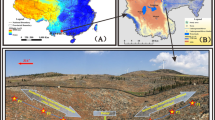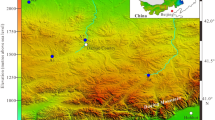Abstract
Vegetation cover plays an important role in the process of evaporation and infiltration. To explore the relationships between precipitation, soil water and groundwater in Taihang mountainous region, China, precipitation, soil water and water table were observed from 2004 to 2006, and precipitation, soil water and groundwater were sampled in 2004 and 2005 for oxygen-18 and deuterium analysis at Chongling catchment. The soil water was sampled at three sites covered by grass (Carex humilis and Carex lanceolata), acacia and arborvitae respectively. Precipitation is mainly concentrated in rainy seasons and has no significant spatial variance in study area. The stable isotopic compositions are enriched in precipitation and soil water due to the evaporation. The analysis of soil water potential and isotopic profiles shows that evaporation of soil water under arborvitae cover is weaker than under grass and acacia, while soil water evaporation under grass and acacia showed no significant difference. Both δ18O profiles and soil water potential dynamics reveal that the soil under acacia allows the most rapid infiltration rate, which may be related to preferential flow. In the process of infiltration after a rainstorm, antecedent water still takes up over 30% of water in the topsoil. The soil water between depths of 0–115 cm under grass has a residence time of about 20 days in the rainy season. Groundwater recharge from precipitation mainly occurs in the rainy season, especially when rainstorms or successive heavy rain events happen.








Similar content being viewed by others
References
Abu-Awwad AM (2001) Influence of different water quantities and qualities on lemon trees and soil salt distribution at the Jordan Valley. Agr Water Manage 52:53–71
Aragu AL, Rozanski K, Gonfiantini R, Louvat D (1995) Isotope effects accompanying vacuum extraction of soil water for stable isotope analyses. J Hydrol 168:159–171
Brodersen C, Pohl S, Lindenlaub M, Leibundgut C, von Wilpert K (2000) Influence of vegetation structure on isotope content of throughfall and soil water. Hydrol Process 14:1439–1448
Cartwright I, Weaver TR, Fifield LK (2006) Cl/Br ratios and environmental isotopes as indicators of recharge variability and groundwater flow: an example from the southeast Murray Basin, Australia. Chem Geol 231:38–56
Clark ID, Fritz P (1997) Environmental isotopes in hydrogeology. Lewis, New York
Craig H (1961) Standard for reporting concentrations of deuterium and oxygen-18 in natural waters. Science 133:1833–1834
Darling WG, Bath AH (1988) A stable isotope study of recharge processes in the English Chalk. J Hydrol 101:31–46
Dunne T, Zhang WH, Aubry BF (1991) Effects of rainfall, vegetation, and microtopography on infiltration and runoff. Water Resour Res 27:2271–2285
Eichinger L, Merkel B, Nemeth G, Salvamoser J, Stichler W (1984) Seepage velocity determinations in unsaturated Quarternary grave. Recent Investigations in the Zones of Aeration, symposium proceedings. Munich, pp 303–313
Foster S, Garduno H, Evans R, Olson D, Tian Y, Zhang WZ, Han ZS (2004) Quaternary Aquifer of the North China Plain—assessing and achieving groundwater resource sustainability. Hydrogeol J 12:81–93
Gazis C, Feng XH (2004) A stable isotope study of soil water: evidence for mixing and preferential flow paths. Geoderma 119:97–111
Gonfiantini R (1978) Standards for stable isotope measurements in natural compounds. Nature 271:534–536
Goni IB (2006) Tracing stable isotope values from meteoric water to groundwater in the southwestern part of the Chad basin. Hydrogeol J 14:742–752
Horton R, Bristow KL, Kluitenberg GJ, Sauer TJ (1996) Crop residue effects on surface radiation and energy balance—review. Theor Appl Climatol 54:27–37
Hou SB, Song XF, Yu JJ, Liu X, Zhang GY (2008) Stable isotopes characters in the process of precipitation and infiltration in Taihang mountainous region. Resour Sci 23:86–92
Hsieh JC, Chadwick OA, Kelly EF, Savin SM (1998) Oxygen isotopic composition of soil water: quantifying evaporation and transpiration. Geoderma 82:269–293
Khanzada AN, Morris JD, Ansari R, Slavich PG, Collopy JJ (1998) Groundwater uptake and sustainability of Acacia and Prosopis plantations in Southern Pakistan. Agr Water Manage 36:121–139
Li FD, Song XF, Tang CY, Liu CM, Yu JJ, Zhang WJ (2007) Tracing infiltration and recharge using stable isotope in Taihang Mt., north China. Environ Geol 53:687–696
Li FD, Pan GY, Tang CY, Zhang QY, Yu JJ (2008) Recharge source and hydrogeochemical evolution of shallow groundwater in a complex alluvial fan system, southwest of North China Plain. Environ Geol 55:1109–1122
Mao RZ, Liu XJ, Li HJ, Li WQ (2003) Dynamic variation of shallow groundwater table in saline and water deficit region of North China Plain. J Exp Bot 54:49
Markus M, Tanny J, Li Y, Cohen S (2004) Measuring and predicting evapotranspiration in an insect-proof screenhouse. Agr Forest Meteorol 127:35–51
Mcginty WA, Smeins FE, Merrill LB (1979) Influence of soil, vegetation, and grazing management on infiltration rate and sediment production of edwards-plateau rangeland. J Range Manage 32:33–37
Mellander PE, Bishop K, Lundmark T (2004) The influence of soil temperature on transpiration: a plot scale manipulation in a young Scots pine stand. Forest Ecol Manag 195:15–28
Pitman AJ, Zhao M, Desborough CE (1999) Investigating the sensitivity of a land surface scheme’s simulation of soil wetness and evaporation to spatial and temporal leaf area index variability within the global soil wetness project. J Meteorol Soc Jpn 77:281–290
Riou C, Itier B, Seguin B (1988) The influence of surface-roughness on the simplified relationship between daily evaporation and surface-temperature. Int J Remote Sens 9:1529–1533
Schachtschneider K, February E (2007) Unravelling the mystery of tree water uptake along a Namibian ephemeral river–Which tree gets what and from where? S Afr J Bot 73:310–311
Shih SF, Rahi GS (1983) Pan evaporation as related to sugarcane leaf-area index. Soil Crop Sci Soc Fl 42:80–85
Thoma G, Esser N, Sonntag C, Weiss W, Rudolph J, Leveque P (1987) New technique of in situ soil moisture sampling for environmental isotope analysis applied at Pilat sand dune near Bordeaux. Isotope Hydrology. IAEA/UNESCO, Vienna, pp 753–766
Wang SQ, Song XF, Wang QU, Xiao GQ, Liu CM (2008) Dynamic features of shallow groundwater in North China Plain. Acta Chimi Sin 63:462–472
Wang P, Song XF, Hou SB (2009) A study of representative vegetation effects on soil water potential in Taihang mountainous region. J Nat Resour 24:1467–1476
Yang YH, Watanabe M, Sakura Y, Tang CY, Hayashi S (2002) Groundwater-table and recharge changes in the Piedmont region of Taihang Mountain in Gaocheng City and its relation to agricultural water use. Water SA 28:171–178
Yepez EA, Huxman TE, Ignace DD, English NB, Weltzin JF, Castellanos AE, Williams DG (2005) Dynamics of transpiration and evaporation following a moisture pulse in semiarid grassland: a chamber-based isotope method for partitioning flux components. Agr Forest Meteorol 132:359–376
Zimmermann U, Münnich K, Roether W (1966) Tracers determine movement of soil moisture and evapotranspiration. Science 152:346–347
Zimmermann U, Ehhalt D, Munnich K (1967) Soil water movement and evapotranspiration: changes in the isotopic composition of the water. In: Proceedings of the IAEA symposium on the use of isotopes in hydrology. IAEA, Vienna, pp 567–584
Acknowledgments
This work was supported by the National Natural Sciences Foundation of China (No. 40671034) and Key Program of National Natural Science Foundation of China: Hydrological Cycle Observing Compare and contrast at different scales catchments: A Case Study of Baiyangdian River Basin (No. 40830636). The collection of water samples was assisted by Water and Soil Conservation Station of Baoding City, Hebei Province of China. The authors give the sincere thanks to Mr. Zhang and other staffs in the station and to Prof. Caitang Liu, Prof. Lin Li for their earnest field work.
Author information
Authors and Affiliations
Corresponding author
Rights and permissions
About this article
Cite this article
Song, X., Wang, P., Yu, J. et al. Relationships between precipitation, soil water and groundwater at Chongling catchment with the typical vegetation cover in the Taihang mountainous region, China. Environ Earth Sci 62, 787–796 (2011). https://doi.org/10.1007/s12665-010-0566-7
Received:
Accepted:
Published:
Issue Date:
DOI: https://doi.org/10.1007/s12665-010-0566-7




